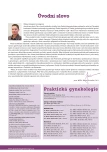Pregnancy loss after the assisted reproductive technologies.
Authors:
L. Hromadová; P. Trávník; K. Veselá; J. Veselý; G. Tauwinklová; E. Oráčová
Authors‘ workplace:
Sanatorium REPROMEDA, Brno
Published in:
Prakt Gyn 2009; 13(2): 93-98
Overview
In connection with the increasing success rate of the assisted reproductive technology we are more interested in the number of pregnancies ending by the healthy children delivery. Our aim is to increase the number of children born after the assisted reproductive treatment. The retrospective analysis of the group of patients experienced the pregnancy loss was performed. Base on it we would like to offer new therapeutic advancements to reduce the pregnancy loss rate. 649 pregnancies following ART methods during 2004–2007 were analysed retrospectively. Infertility factors, ART methods, applied stimulation protocol, patient’s age and gestational age were observed. All pregnancies types including TOP and loss during the delivery were analysed. Base on tests performed before the treatment procedure was indicated. Total pregnancy loss was 125 (19,3 %), the most frequent missed abortion till the 12th week (10,9 %) and spontaneous abortion (2,0 %). Almost comparable are pregnancy loss rate in case of tubal (21,3 %), ovarian (16,9 %), genetic (18,2 %) and male (18,2 %) factor and endometriosis (20,5 %). Immunologic factor is 50,0 % and idiopathic factor is 31,0 %. In case of depot GnRH agonist use the pregnancy loss rate was 18,8 %, non‑depot GnRH agonist 16,0 %. Use of GnRH antagonist produced 23,6 % loss. In connection with separate methods following results were obtained: ICSI 18,4 %, PGD 20,2 %, OD 25,5 %, TESE 0 %, FET 35,9 %. The average age of women was 30,9 years, the average age of men 32,4. The majority of pregnancies is lossed till the end of the 7th week. The pregnancy loss rate is comparable to data indicated by others authors and even lower compare to some others. Looked on the miscarriages only, the rate is really low, 12,9 %. Ectopic pregnancy rate is also low, 1,2 %. High pregnancy loss rate is found among pregnancies following frozen-thawed embryo transfer, which is according to general presumptions, and among women with immunologic and idiopathic infertility factor. The difference between the GnRH agonist and GnRH antagonist group is significant on behalf of agonists. The average client’s age doesn’t differ from the age of treated couples.
Key words:
pregnancy loss – abortion – infertility – assisted reproductive technology
Sources
1. Farr SL, Schive LA, Jamieson DJ. Pregnancy Loss among Pregnancies Conceived through Assisted Reproductive Technology, United States, 1999–2002. American Journal of Epidemiology 2007; 165(12): 1380–1388.
2. Reddy UM. Opakované těhotenské ztráty: negenetické příčiny. Gynekologie po promoci 2007; 7(5): 14–18.
3. Roztočil A. Opakované těhotenské ztráty: negenetické příčiny. Gynekologie po promoci 2007; 7(5): 20–23.
4. Madar J, Nouza K, Nováková D. Imunologické aspekty habituálního potrácení. Moderní gynekologie a porodnictví 2002; 11(4): 621–627.
5. Mardešič T. Indikace a výsledky léčby sterility metodami asistované reprodukce. Moderní gynekologie a porodnictví 2002; 11(4): 565–571.
6. Wang JX, Norman RJ, Wilcox AJ. Incidence of spontaneous abortion among pregnancies produced by assisted reproductive technology. Human Reproduction 2004; 19(2): 272–277.
7. Tummers P, De Sutter P, Dhont M. Risk of spontaneous abortion in singleton and twin pregnancies after IVF/ICSI. Human Reproduction 2003; 18(8): 1720–1723.
8. Salumets A, Suikkari AM, Mäkinen S et al. Frozen embryo transfers: implications of clinical and embryological factors on the pregnancy outcome. Human Reproduction 2006; 21(9): 2368–2374.
9. Winter E, Wang J, Davies MJ et al. Early pregnancy loss following assisted reproductive technology treatment. Human Reproduction 2002; 17(12): 3220–3223.
10. Magli MC, Gianaroli L, Fortini D et al. Impact of blastomere biopsy and cryopreservation techniques on human embryo viability. Human Reproduction 1999; 14(3): 770–773.
11. Joris H, Van den Abbeel E, De Vos A et al. Reduced survival after human embryo biopsy and subsequent cryopreservation. Human Reproduction 1999; 14(11): 2833–2837.
12. Kolibianakis EM, Albano C, Kahn J et al. Exposure to high levels of luteinizing hormone and estradiol in the early follicular phase of gonadotropin‑releasing hormone antagonist cycles is associated with reduced chance of pregnancy. Fertility Sterility 2003; 79(4): 873–880.
13. Kolibianakis EM, Tarlatzis B, Devroy P. GnRH antagonists in IVF. Reproductive BioMedicine Online 2005; 11(2): 271.
14. Prapas N, Prapas Y, Panagiotidis Y et al. GnRH agonist versus GnRH antagonist in oocyte donation cycles: a prospective randomized study. Human Reproduction 2005; 20(6): 1516–1520.
15. Řežábek K. Komplikace léčby sterility. Moderní gynekologie a porodnictví 2002; 11(4): 580–588.
16. Clayton HB, Schieve LA, Peterson HB et al. Ectopic pregnancy risk with assisted reproductive technology procedures. Obstetrics Gynecology 2006; 107(3): 595–604.
Labels
Paediatric gynaecology Gynaecology and obstetrics Reproduction medicineArticle was published in
Practical Gynecology

2009 Issue 2
Most read in this issue
- Intrahepatic cholestasis of pregnancy and treatment with ursodeoxycholic acid.
- Pregnancy loss after the assisted reproductive technologies.
- Thyroid cancer therapy with radioiodine 131I, the impact on gonadal functions and fertility.
- Perioperative adhesion prevention in gynaecology.
